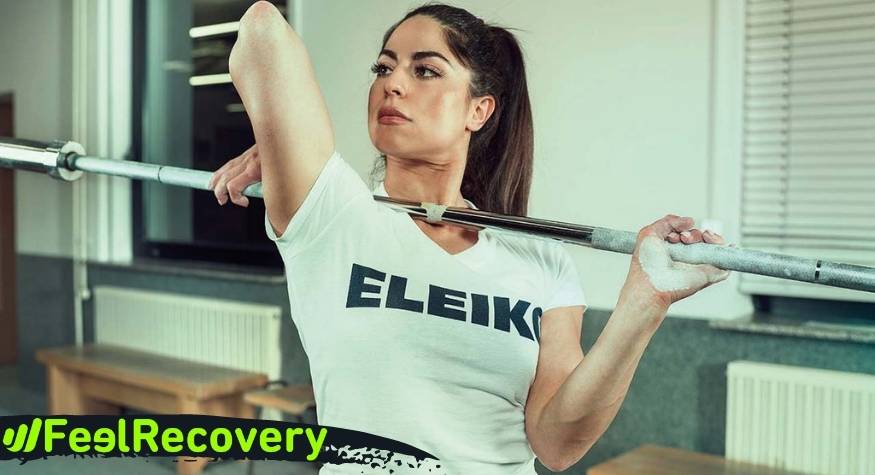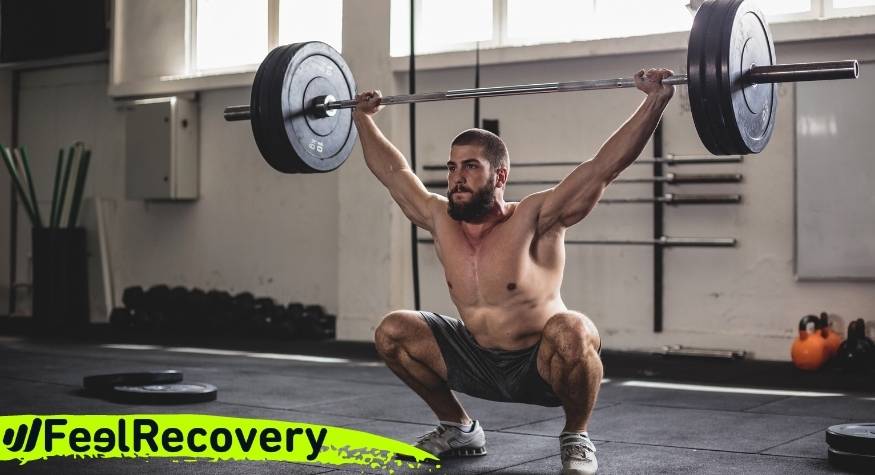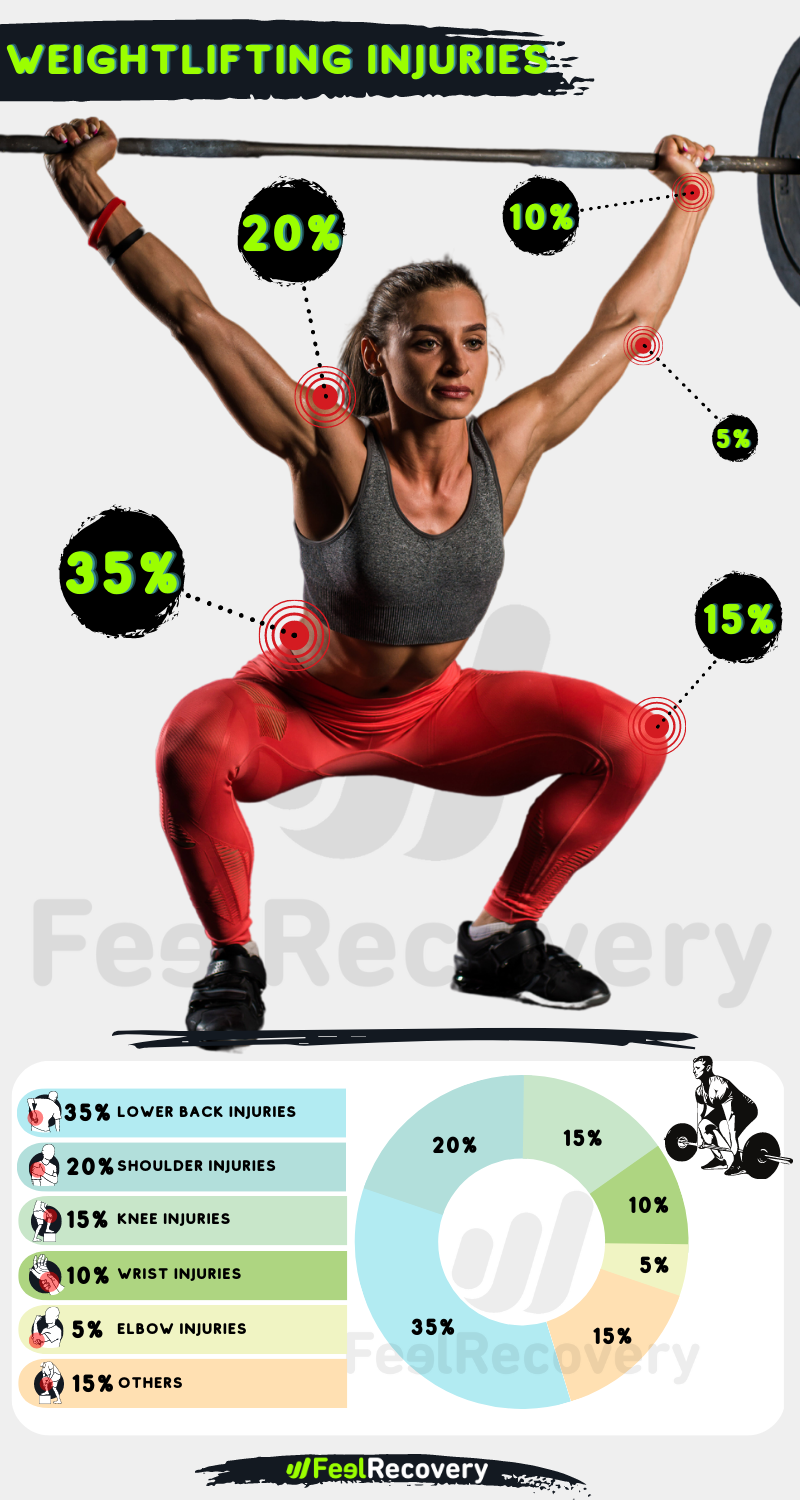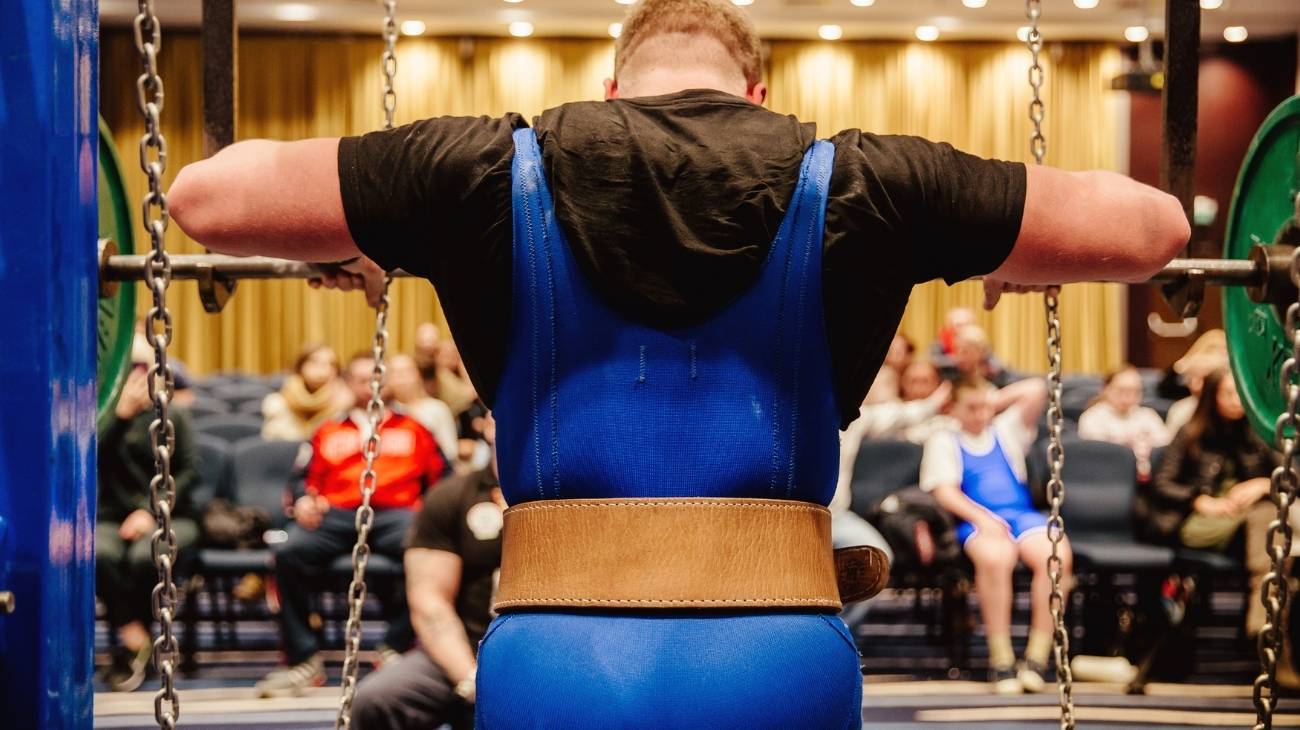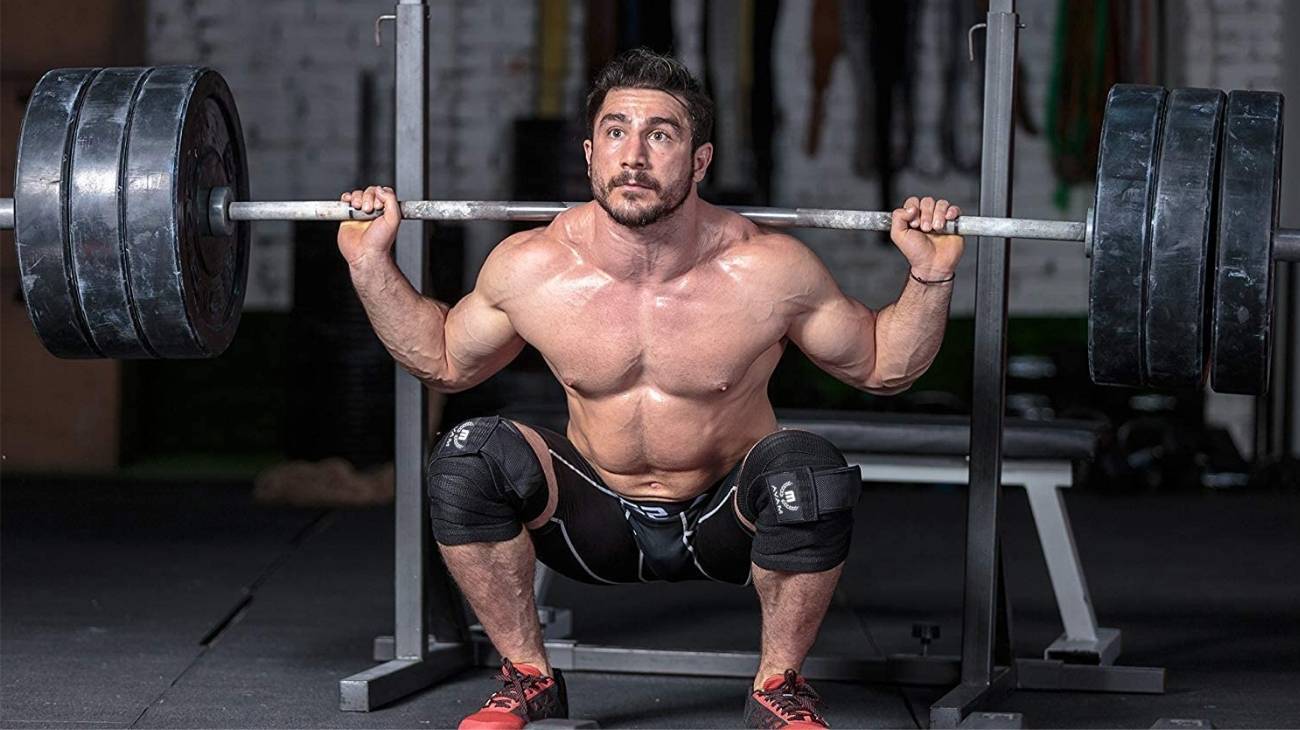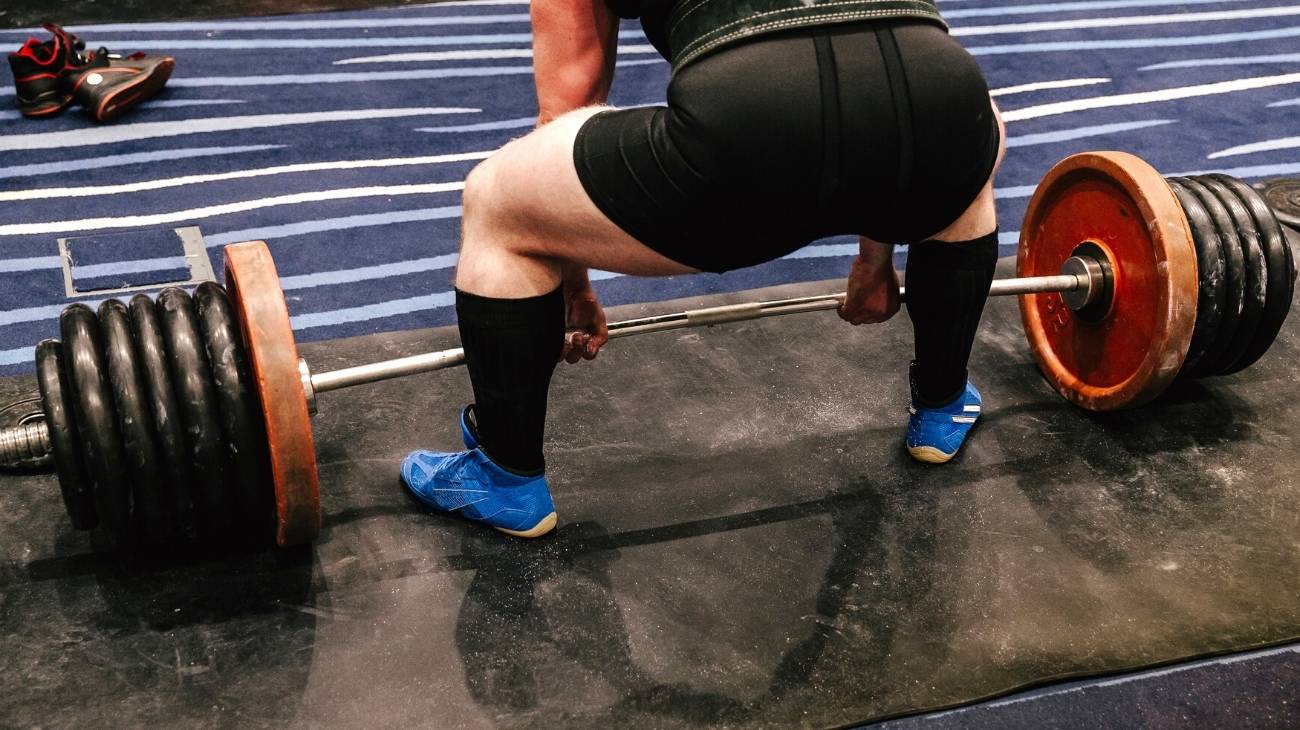It is true that weightlifting is a high-intensity sport, but the injury rate is 10 times lower than in football, for example. For every thousand hours of training, there are on average 5 injuries; in football the average is 50 injuries.
The only difference is that in weightlifting, the damage is usually chronic due to the load the body endures and the athlete pushes his body to the limit. Check out the most common weightlifting injuries, learn how to prevent the ailments and correctly apply the PRICE therapy during first aid.
What are the most common types of weightlifting and powerlifting injuries?
If you didn't know, most injuries occur in competitions, where the athlete pushes his or her body to the extreme in search of the best scores. More than 40% of cases of discomfort are due to an overload of body tension.
Check out this list of the most common weightlifting injuries, whether you are a professional or amateur weightlifter:
Elbow injuries
The elbows are one of the joints that suffer the most, especially in two-stroke lifts, since the first impulse makes them support almost all the weight of the bar for a few seconds. Among the most common injuries we can identify the following:
- Elbow fracture: The radius is the bone that suffers most from the strong muscular tension due to the weight of the discs. Poor technique is often the cause of an elbow fracture and this can be in one or more pieces. Nerves in the platform, pressure from being the best or simply a bad warm-up will cause the soft tissues to give way in the lift and the pressure falls on the bones.
- Elbow dislocation: The elbow has a very rigid stability because it is a joint with a low range of motion. Any sideways movement in the lunge will cause the elbow to shift and dislocate, i.e., slip out of place. The weight of the discs and the bad manoeuvre of the athlete have generated most of the known cases of elbow dislocations in weightlifting.
- Tendonitis: This is one of the most minor injuries in weightlifting. It is the inflammation of the tendons that give mobility and stability to the elbow, and that hold the muscles to the bones. This is an injury caused by the intense grip of the hands on the Olympic bar. The pressure generated in the fingers causes the strain to negatively impact the tendons in the elbow.
Back and lumbar injuries
The back and lumbar area is where the main serious injuries for a weightlifter lie, as the vertebrae always suffer an important wear and tear causing ailments such as:
- Lower back strain: The inclined position the weightlifter adopts and then the abrupt lifting of the bar causes the tendons and muscle fibres of the lower back to be injured if they have been properly warmed up. This is unlikely to be due to poor technique, but is likely to be due to poor muscle preparation.
- Degenerative disc disease: This is caused by constant and repeated stress on the discs of the spine. It is a disease that arises with years of intense training and competitions. Contrary to what you think, no matter how much you take care of your technique, there will always be a significant wear and tear on the body's tissues and bone structure, so weightlifting is not a sport to be practised for life.
- Muscle contracture: We are talking about an alteration in the muscles' ability to return to a calm state after a contraction. When the muscles are not able to relax, they remain tense and there is local pain. This contraction is involuntary and we must be patient before trying to make new intense movements. As there are large muscles in the back, you are likely to feel the pain in several areas.
Knee injuries
- Tendon degeneration: Like football and Crossfit, weightlifting has a degenerative impact on the patellar tendon. This tissue is subjected to excessive stress, which gradually destroys the cells that make it up, and the situation worsens with the age of the athlete.
- Meniscal tear: The role of the meniscus is fundamental in this sport: to maintain the balance of the body while the person is standing. The menisci also wear out with excess load on the body, so they stop cushioning the weight of the rubber discs in the lower limbs until there is an imbalance and dangerous movements in the knee.
- Knee sprain: When the athlete loses focus and balance of the weight twice his body weight, the knee is likely to perform an inappropriate and involuntary movement until a sprain occurs. When the collateral ligaments and cruciate ligaments do not support the weight of the bar, they twist sharply and tear the tissues. Because of the energy overload on the knee, any movement will be sudden enough to make the injury chronic.
Best products for weightlifting injury recovery
Bestseller
-
2 Calf Compression Sleeve (Black/Gray)
$19.95 -
2 Calf Compression Sleeve (Green/Navy)
$19.95 -
2 Calf Compression Sleeve (Pink/Bordeaux)
$19.95 -
2 Elbow Compression Sleeve (Black/Gray)
$19.95 -
2 Elbow Compression Sleeve (Green/Navy)
$19.95 -
2 Elbow Compression Sleeve (Pink/Bordeaux)
$19.95 -
2 Knee Compression Sleeve (Black/Gray)
$19.95 -
2 Knee Compression Sleeve (Green/Navy)
$19.95 -
2 Knee Compression Sleeve (Pink/Bordeaux)
$19.95 -
2 Thigh Compression Sleeve (Black/Gray)
$19.95 -
2 Thigh Compression Sleeve (Green/Navy)
$19.95 -
2 Thigh Compression Sleeve (Pink/Bordeaux)
$19.95 -
Acupressure Mat and Pillow (Black/Gray)
$49.95 -
Acupressure Mat and Pillow (Green/Navy)
$49.95 -
Acupressure Mat and Pillow (Pink/Bordeaux)
$49.95 -
Acupressure Pillow (Black/Gray)
$29.46 -
Acupressure Pillow (Green/Navy)
$29.46 -
Acupressure Pillow (Pink/Bordeaux)
$29.46 -
Back Support Belt (Black)
$34.95 -
Back Support Belt (Green)
$34.95 -
Back Support Belt (Pink)
$34.95 -
Foot Massage Roller for Plantar Fasciitis (Black)
$19.95 -
Foot Massage Roller for Plantar Fasciitis (Green)
$19.95 -
Foot Massage Roller for Plantar Fasciitis (Pink)
$19.95 -
High Density Foam Roller for Muscle (Black/Gray)
$29.95 -
High Density Foam Roller for Muscle (Green/Navy)
$29.95 -
High Density Foam Roller for Muscle (Pink/Bordeaux)
$29.95 -
Ice Massage Roller Ball (Black)
$39.95 -
Ice Massage Roller Ball (Green)
$39.95 -
Ice Massage Roller Ball (Pink)
$39.95 -
Microwave Heating Pad for Back Pain Relief (Extra Large) (Hearts)
$29.95 -
Microwave Heating Pad for Back Pain Relief (Extra Large) (Oxford)
$29.95 -
Microwave Heating Pad for Back Pain Relief (Extra Large) (Sport)
$29.95 -
Microwave Heating Pad for Neck & Shoulder Pain Relief (Hearts)
$24.95 -
Microwave Heating Pad for Neck & Shoulder Pain Relief (Oxford)
$24.95 -
Microwave Heating Pad for Neck & Shoulder Pain Relief (Sport)
$24.95 -
Pack 2 In 1 Foam Roller High + Soft Density (Black/Gray)
$29.95 -
Pack 2 In 1 Foam Roller High + Soft Density (Green/Navy)
$29.95 -
Pack 2 In 1 Foam Roller High + Soft Density (Pink/Bordeaux)
$29.95 -
Sacroiliac Support Belt (Black)
$24.95 -
Sacroiliac Support Belt (Green)
$24.95 -
Sacroiliac Support Belt (Pink)
$24.95 -
Shoulder Support Brace (Black)
$24.95 -
Shoulder Support Brace (Green)
$24.95 -
Shoulder Support Brace (Pink)
$24.95 -
Soft Density Foam Roller for Recovery (Black)
$29.95 -
Soft Density Foam Roller for Recovery (Green)
$29.95 -
Soft Density Foam Roller for Recovery (Pink)
$29.95 -
Trigger Point Massage Stick (Black)
$14.95 -
Trigger Point Massage Stick (Green)
$14.95 -
Trigger Point Massage Stick (Pink)
$14.95
How to prevent injuries when weightlifting or gym training?
Preventing injuries is more important than recovering from them. Once an injury has occurred, the affected area is sensitive and is likely to be susceptible to recurrence. For this reason, we show you how to prevent weightlifting injuries from different aspects of the sport.
- Warm up well: by warming up we want to increase body temperature, achieve the greatest range of motion in the joints, facilitate motor action and achieve better coordination of the nervous system. Do general warm-ups such as walking and stationary cycling, then apply specific warm-ups such as joint movements in the neck and shoulder. Don't forget to do circular movements on both upper and lower limbs. Your body will thank you for it when you're on the Olympic platform.
- Finish your workouts with a cool down: abdominal exercises and hamstring stretches are a simple way to allow the body to return to its calm state. We must give the heart rate and blood pressure a chance to return to the calm they were before the warm-up. Why is it important to cool down the body? Because we will allow it to drain the toxins that the body emits when training, because the soft tissues can be prepared for the next workout without aches and pains, and because there can be contractures and cramps when we stop training suddenly.
- Good nutrition and hydration: As proteins are the components that feed the muscles, the diet of a weightlifter should be based on a sufficient consumption of chicken, turkey, milk, eggs, fish and cheese with a minimum percentage of fat. However, fat should only make up 30% of an athlete's diet. As for hydration, drink water every 20 minutes while training, avoid training with a full stomach, even if it is only water, because you will be in an unwanted state of heaviness.
- Improve your fitness: as you have read in this article, it is not appropriate to have an uncontrolled increase in muscle mass without an increase in strength. Muscle hypertrophy is a slow process of months of general and focused training on every muscle in your body to make it strong, resilient and healthy. You must not have excess fat, all muscles must be based on fibre and not fat.
- Sports massage: when we notice that there is difficulty in muscle functions, sports massages allow a better relaxation of the fibres of these tissues. By applying a mechanical force to the body, the muscles regain the elasticity that characterises them and thus regain excellent performance in competition. Massage helps prevent injuries, accelerates recovery from ailments, promotes muscular endurance and improves blood circulation, so that nutrients reach the soft tissues better.
- Use of heat and cold therapies: both therapies are used for different purposes, depending on the needs of the athletes. If better recovery from injury is desired, cold is ideal in the first few minutes after discomfort. It reduces blood circulation, bruising and tissue swelling. At the same time, heat allows the muscles to be at an adjusted temperature, depending on whether it is a training or competition requirement
- Use of compression garments: In weightlifting, athletes may only wear compression stockings in competitions and Olympics. It is very dangerous to try to win medals if you are trying to hide a previous injury. The jersey in training can cover the whole trunk and arms, so there will be a better muscular performance. However, on the downside, you should not overdo it, as you will accustom the body to depend on this compressive garment.
- Use of acupressure therapies: This therapy establishes that the human body has local points, activation points and meridians that allow the energy or "Chi" accumulated in strategic areas to flow. The accumulation of energy translates into muscular tension, a concept already known to every professional trainer and athlete. Knots in the tissues prevent better performance.
- Use of thermotherapy and cryotherapy: this is the application of cold and heat at extreme levels and seeks long-term benefits Cold is used at an average temperature of -130°C to eliminate defective muscle cells and protect healthy ones. It is a therapy that is often full body and lasts no more than a few seconds. As for heat, it has long-term healing powers in case of serious injuries such as muscle tears.
- Use of appropriate equipment: in addition to the jersey mentioned above, athletes should wear a protective belt to reduce the likelihood of lower back injuries. It is also advisable to use flexible wrist straps, which do not restrict the free movement of the hand when resting the Olympic barbell on the athlete's chest and shoulders. The shoes should fit properly and have two or three centimetres of elevation in the sole for better posture.
How to apply the RICE therapy to treat first aid injuries in weightlifting?
The PRICE therapy is a form of first aid that you should apply in case of soft tissue injuries. Under no circumstances should you use it if you know there is a third degree sprain or fracture.
In the late 1970s, this method began to be used, but it was better known as RICE. It is now named PRICE with an update at the beginning of the steps.
- Protection: This consists of using a classic bandage to give minimal protection to the injury and thus avoid the likelihood that the natural movements of the body will damage the clinical picture. Go to a calm place where you can sit down if the injury is in the upper extremities or lie down if the injury is in the legs.
- Rest: This should last at least 48 to 72 hours if you see favourable changes in the injury. Even if you are not sick, whenever something is wrong with your body, you should always rest. You can only do gentle movements when your sports doctor and trainer tell you to, otherwise it will only complicate the damaged tissue.
- Ice: Apply a good piece of ice with the support of a scarf or heat pack. You should not apply it directly to the skin because it will generate slight burns and the remedy will be worse than the disease. The duration of the ice should not exceed 20 minutes, then you should offer a rest of 10 minutes and resume the use of ice.
- Compression: Its purpose is to provide some pressure on the affected limb, you will see how the inflammation and pain begin to go down little by little. If you notice tingling in the area of the bandage, it is advisable to loosen it a little.
- Elevation: For the upper and lower limbs, it is easy to elevate them above the level of the heart. This will help the effect of the ice and compression on the damaged tissue. In the lower back this elevation is not possible, but you can try placing pillows on your back if that makes you feel more comfortable. It is recommended that the spine is completely straight.
References
- Aasa, U., Svartholm, I., Andersson, F., & Berglund, L. (2017). Injuries among weightlifters and powerlifters: a systematic review. British journal of sports medicine, 51(4), 211-219. https://bjsm.bmj.com/content/51/4/211.short
- Mazur, L. J., Yetman, R. J., & Risser, W. L. (1993). Weight-training injuries: common injuries and preventative methods. Sports Medicine, 16, 57-63. https://link.springer.com/article/10.2165/00007256-199316010-00005
- Keogh, J. W., & Winwood, P. W. (2017). The epidemiology of injuries across the weight-training sports. Sports medicine, 47(3), 479-501. https://link.springer.com/article/10.1007/s40279-016-0575-0
- Siewe, J., Rudat, J., Röllinghoff, M., Schlegel, U. J., Eysel, P., & Michael, J. P. (2011). Injuries and overuse syndromes in powerlifting. International journal of sports medicine, 32(09), 703-711. https://www.thieme-connect.com/products/ejournals/abstract/10.1055/s-0031-1277207
- Hamill, B. P. (1994). Relative safety of weightlifting and weight training. J Strength Cond Res, 8(1), 53-7. https://paulogentil.com/pdf/Relative%20Safety%20of%20Weightlifting%20and%20Weight%20Training.pdf
- Brown, E. W., & Kimball, R. G. (1983). Medical history associated with adolescent powerlifting. Pediatrics, 72(5), 636-644. https://publications.aap.org/pediatrics/article-abstract/72/5/636/49023/Medical-History-Associated-with-Adolescent
- Bengtsson, V., Berglund, L., & Aasa, U. (2018). Narrative review of injuries in powerlifting with special reference to their association to the squat, bench press and deadlift. BMJ Open Sport & Exercise Medicine, 4(1), e000382. https://bmjopensem.bmj.com/content/4/1/e000382.abstract
- Ángel Rodríguez, M., García-Calleja, P., Terrados, N., Crespo, I., Del Valle, M., & Olmedillas, H. (2022). Injury in CrossFit®: a systematic review of epidemiology and risk factors. The Physician and Sportsmedicine, 50(1), 3-10. https://www.tandfonline.com/doi/abs/10.1080/00913847.2020.1864675
- Mundt, D. J., Kelsey, J. L., Golden, A. L., Panjabi, M. M., Pastides, H., Berg, A. T., ... & Hosea, T. (1993). An epidemiologic study of sports and weight lifting as possible risk factors for herniated lumbar and cervical discs. The American journal of sports medicine, 21(6), 854-860. https://journals.sagepub.com/doi/abs/10.1177/036354659302100617
- Reddell, C. R., Congleton, J. J., Huchingson, R. D., & Montgomery, J. F. (1992). An evaluation of a weightlifting belt and back injury prevention training class for airline baggage handlers. Applied ergonomics, 23(5), 319-329. https://www.sciencedirect.com/science/article/abs/pii/0003687092902935




















































































